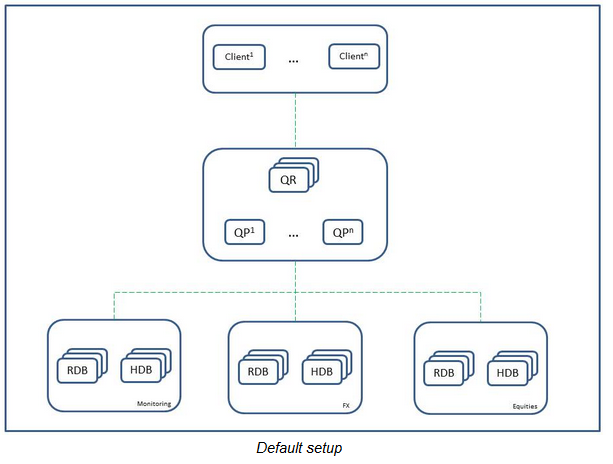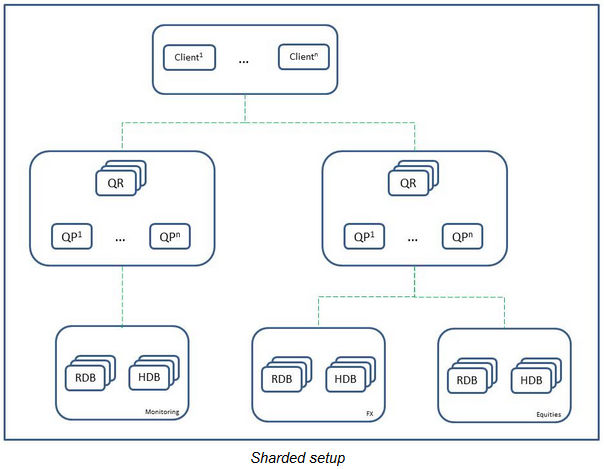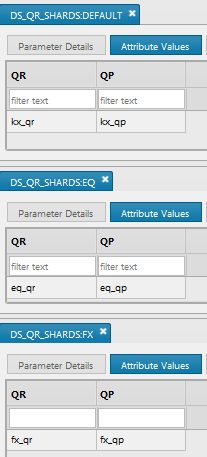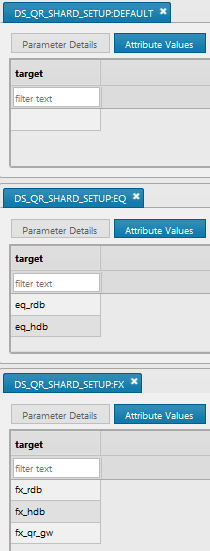Sharding

By default, the QR framework is treated as one single cluster of processes. All client requests into the system are routed through a single leader QR. However having all requests routed through a single process can be a scalability concern as this process needs to manage database availability, client registrations, request timeouts, in addition to routing requests. At some point it won't be able to handle the load and performance will degrade.
The other limitation is around flexibility. The framework allows for customization's to multiple areas (routing decisions, request parsing, QP dispatch). Customizations for one product will affect all other products on that system, i.e. if the routing rules are changed for monitoring, they will change for all others because they share the same cluster.
Sharded framework
Splitting the framework into shards addresses these issues by splitting the request load across multiple QR clusters and allowing customization's possible to the processes independently.

The most important thing to note here is that each target will be assigned to a single QR cluster. The reason for this is that the QR manages the availability of a process and if the database registered with multiple QRs, there would be no way to reliably manage that. For this reason routed requests (ones which target multiple underlying databases) can only route to databases in the same cluster.
Data sources
Request targets can be;
- Instances
- Connections
- Connection groups
- Services
- Service classes
All of these need to be assigned to a QR cluster. This will be done via configuration with a default cluster for unconfigured ones.
Interfaces
All client interactions with the QR framework are through KX Delta Platform interfaces. These support sharding so the client does not need to know about the sharding setup. These interfaces read the sharding config and can map requests to the corresponding QR. They connect to each cluster and route to the leader QR for each.
Setup
In order to simplify the setup and support elastic scalability, the QR and QP processes will run as services. This makes scaling up and down the cluster greatly simplified as it doesn't require any pre-configuration or maintaining another instance. The service can be started and stopped as required with the cluster and clients reacting appropriately.
To enable QR sharding, firstly set the following environment variable in the delta.profile. This instructs the environment to use services for the QR and QP framework processes.
DELTACONTROL_QR_USESERVICES=YES
This can be set during installation of KX Delta Platform.
Add enable-qr-sharding=1 to your install.config file.
For more details on the KX Delta Platform deployment process, see the KX Delta Platform Deployment guide.
A shard consists of one QR and one QP service class name. All services that run under one of the two classes, automatically join that shard. The shards are defined using overrides of the DS_QR_SHARDS config parameter. In the below example, three shards have been configured using six different service classes; three QRs and three QPs.

Targets are mapped to shards using the DS_QR_SHARD_SETUP config parameter. The override name should match the one used for DS_QR_SHARDS in order to complete the assignment. If a target isn't explicitly assigned to a shard, it will use the DEFAULT.

As discussed, databases are only assigned to a single cluster. They read the above config and only register with their assigned cluster. Clients read the config in order to route requests to the correct QRs.
Client examples
Since the interfaces handle the routing to correct clusters, the client can remain agnostic of the underlying setup. Some example requests are executed below using the kdb+ client APIs.
Standard request
Assuming the fx_rdb target is assigned to the FX shard. This request will be dispatched to the leader QR for that shard, with the results returned via one of the FX QPs.
.qr.client.sendRequest["select from fxQuote"; `fx_rdb; { show x }; ()!()]
Routed request
Assuming the .fx.getQuotes API is setup as routed, the below API will send a request to the FX shard.
.qr.client.sendRequest[(`.fx.getQuotes; .z.d-1; .z.d; `); `fx_rdb; { show x }; ()!()]
Routed request target
Even though the QR process works out the request targets in this case, the client still needs to specify one. This value should be a target assigned to the correct shard; FX in this case.